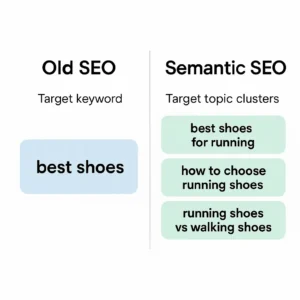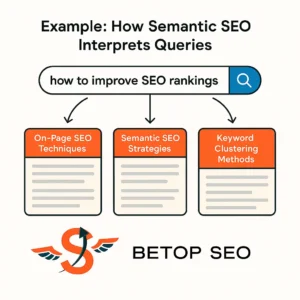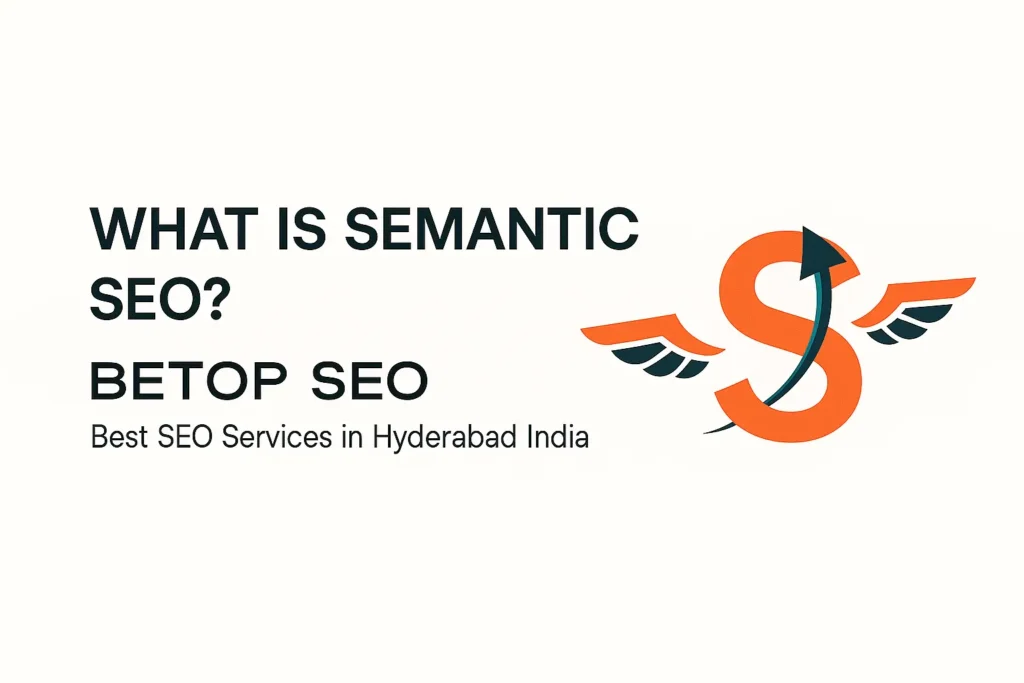Table of Contents
ToggleIntroduction: Understanding the Meaning Behind Modern SEO
Search engines are becoming smarter. Today, they don’t just read your keywords — they understand what you mean. This evolution gave rise to Semantic SEO, a modern approach that focuses on context, intent, and meaning, not just word matching.
At BeTopSEO, we help businesses in Hyderabad, India, and beyond adapt to this new reality by creating content that search engines understand and audiences trust.
What Exactly Is Semantic SEO?
Semantic SEO is the process of optimizing your content so that search engines can understand its true meaning — not just the keywords used in it. It involves structuring your content around topics, entities, and relationships that reflect how real users think and search.
The Shift from Keyword SEO to Semantic SEO
Traditional SEO was all about inserting target keywords multiple times. But after Google’s updates (like Hummingbird, RankBrain, and BERT), the algorithm started analyzing intent behind the query.
For instance:
Old SEO: Target keyword “best shoes”
Semantic SEO: Target topic clusters like “best shoes for running,” “how to choose running shoes,” “running shoes vs walking shoes.”

The Role of Search Intent and Context
Every search has a purpose — that’s search intent. Semantic SEO helps align your content with the why behind a search.
Google then connects your content to the right users based on that intent and surrounding context.
How Semantic SEO Works
Google’s Understanding of Meaning Through Entities
Google’s Knowledge Graph links entities — people, places, things, or concepts — that are connected by meaning.
When you write content about “Apple,” Google uses entities to decide whether you’re referring to the tech company or the fruit.
NLP (Natural Language Processing) and Semantic Search
Through Natural Language Processing (NLP), Google interprets how words relate to each other. It reads your content like a human — understanding tone, relationships, and purpose.
Example: How Semantic SEO Interprets Queries
A search for “how to improve SEO rankings” doesn’t just look for pages with those exact words. Google now looks for:

Articles explaining “on-page SEO techniques”
“Semantic SEO strategies”
“Keyword clustering methods”
That’s semantic search in action.
Key Benefits of Using Semantic SEO
1. Better Search Rankings
When you structure content semantically, Google sees your website as an authority on the entire topic, not just a keyword. This boosts visibility across related searches.
2. Higher User Engagement and Dwell Time
When users find meaningful, context-rich content that answers all their questions, they stay longer — a positive signal for rankings.
3. Improved Content Relevance and Authority
Semantic optimization creates a strong connection between pages, helping your website build topical depth and trust with search engines.
Practical Examples of Semantic SEO in Action
Example 1: How a Blog on “Apple” Differs in Meaning
If your article is about the fruit, you’d use context like:
“Apple is a nutritious fruit rich in vitamin C and fiber.”
If it’s about the tech brand, your content would say:
“Apple Inc. is known for innovative products like the iPhone and MacBook.”
Same word — different entities. Semantic SEO ensures Google understands the difference.
Example 2: Optimizing for “Best Laptops for Students”
Instead of stuffing “best laptops” everywhere, semantically optimized content includes:
“Affordable laptops for college students”
“Lightweight laptops for travel”
“Best laptop battery life for study use”
Google reads this as comprehensive content, not repetition.
How to Implement Semantic SEO on Your Website
1. Focus on Topics, Not Just Keywords
Create topic clusters — one pillar page for the main topic and supporting articles for subtopics. For example:
Pillar: “Semantic SEO Guide”
Cluster: “What Is Semantic SEO,” “How Semantic Search Works,” “Semantic Keyword Research”
2. Build Topic Clusters and Internal Links
Interlink your articles strategically. Each link reinforces your site’s structure, making it easier for Google to understand context and hierarchy.
3. Use Schema Markup and Structured Data
Add structured data to define your content clearly for search engines. Schema markup helps Google connect your articles to relevant entities.
Tools That Help with Semantic SEO
MarketMuse, SurferSEO, and Frase.io
These tools analyze top-ranking pages and suggest semantic terms that should appear naturally in your content.
Google NLP and InLinks for Entity Mapping
They visualize how your content connects semantically across the web, helping you fill topic gaps and strengthen relevance.
Why Semantic SEO Is the Future of Search
Semantic SEO aligns perfectly with the direction search is headed — AI-driven, intent-based, and conversational.
As voice and visual search grow, your website must communicate in a way machines can understand contextually.
That’s exactly what Semantic SEO achieves — it bridges human understanding and algorithmic intelligence.
Conclusion: Start Your Semantic SEO Journey with BeTopSEO
At BeTopSEO, we specialize in building semantic, intent-driven SEO strategies that make your website not just visible — but understood.
Our Hyderabad-based team leverages AI tools, structured data, and NLP-driven insights to help businesses dominate search rankings through smarter, contextual optimization.
If you’re ready to upgrade from traditional SEO to Semantic SEO, let’s build a content strategy that speaks the language of both users and search engines.
👉 Start your Semantic SEO transformation today with BeTopSEO – Best SEO Services in Hyderabad, India.
Visit: www.betopseo.com
FAQs About Semantic SEO
No, it’s about understanding context, intent, and topic relationships — not just swapping words.
It helps small businesses rank for multiple related queries and build topical authority faster.
Yes! Start by writing content around topics, not just keywords, and use clear internal linking.
It’s not mandatory but highly recommended — it improves how Google understands your content.
Typically, 3–6 months depending on competition, content quality, and link authority.

